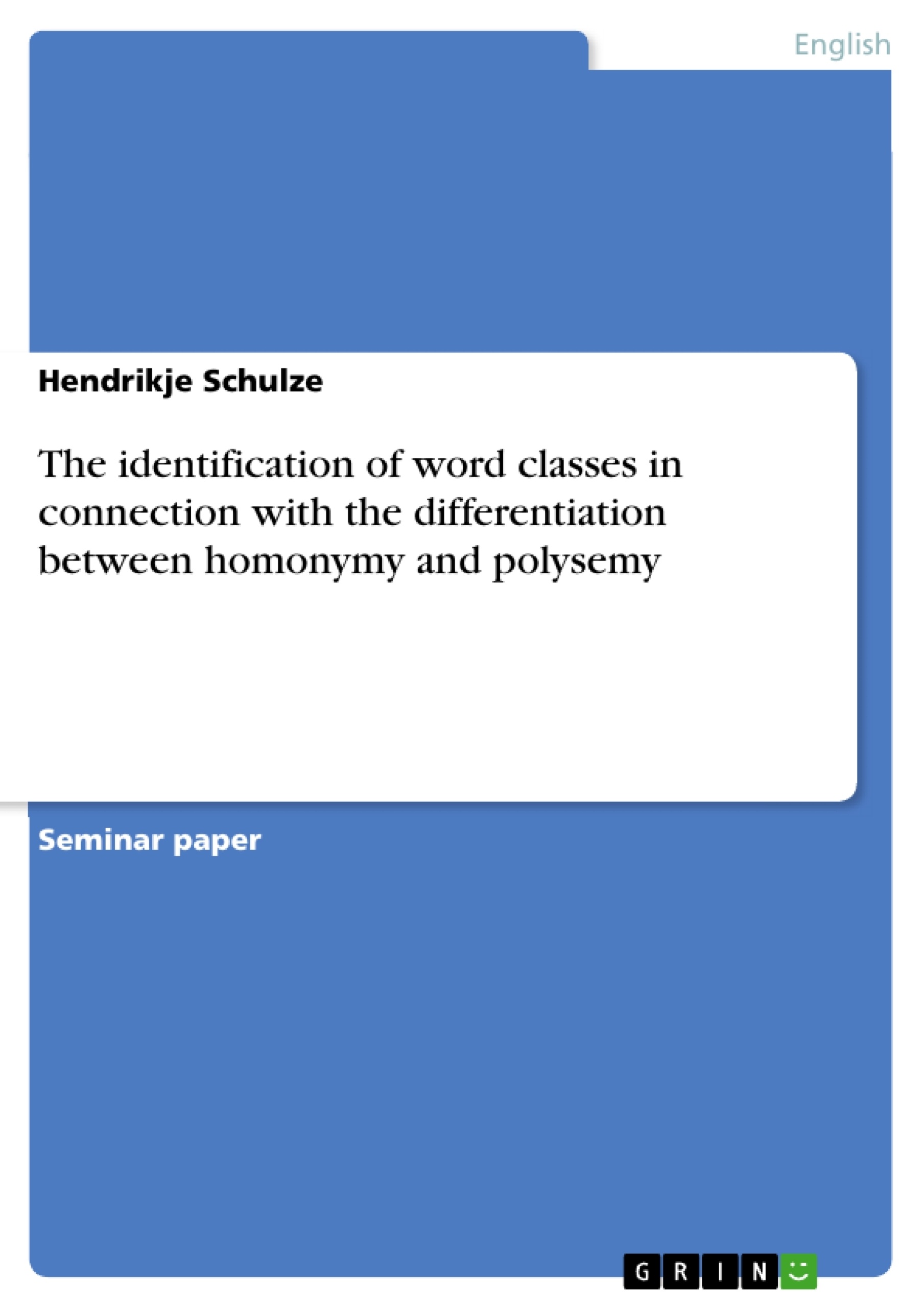This paper is concerned with the linguistic phenomena of homonymy and polysemy. The term homonymy goes back to the Greek words "homós", meaning "the same", and "ónoma", meaning name. A simplified translation of homonymy would be "having the same name".
The term polysemy goes back to the Greek language, too. It is composed of the words "polys", meaning "a lot of", and "sema", which can be translated with "meaning". Simply said polysemy is the phenomenon of one word carrying different meanings.
Homonymy as well as polysemy are rather complex linguistic phenomena. Both have been discussed in connection with each other for a long time. The central point of discussion is the question whether one is confronted with different lexical items which are formally identical, i.e. homonymy, or whether there is just one single lexical item with different meanings, i.e. polysemy. This is especially important with regard to lexicography. It plays also a role in connection with the classification of word classes.
Different criteria have been introduced to distinguish clearly between homonymy and polysemy. Nevertheless, the question remains whether an unambiguous distinction can really be made. This question will be discussed in the following paper.
Table of Contents
- Introduction
- Lexical Entry, Lexical Unit and Lexeme
- The Concept of the Binary Sign by Ferdinand de Saussure
- Paradigmatic Relations between Lexical Items
- The Differentiation between Homonymy and Polysemy
- Etymology
- Formal Identity or Distinctness
- Close Semantic Relatedness
- Lipka's Conclusions
- The Identification of Word Classes
- Analysis
- Way of Procedure
- Virginia Woolf: To the Lighthouse
- Comparison of the verb to tear (zerreißen) and the noun tear (die Träne)
- Comparison of the verb to dust (abstauben) and the noun dust (der Staub)
- Conclusions
Objectives and Key Themes
This paper explores the linguistic phenomena of homonymy and polysemy, examining the key question of how to differentiate between these two concepts. The paper delves into the definitions of lexical entry, lexical unit, and lexeme, utilizing the binary sign concept proposed by Ferdinand de Saussure to analyze the relationships between words.
- Distinguishing between homonymy and polysemy
- The role of lexical entry, lexical unit, and lexeme
- Saussure's binary sign concept in analyzing linguistic relationships
- Paradigmatic relations between lexical items
- The application of these concepts to real-world examples
Chapter Summaries
- Introduction: This chapter introduces the paper's focus on homonymy and polysemy, explaining the terms and their significance in linguistics. It also highlights the ongoing debate about differentiating between these phenomena.
- Lexical Entry, Lexical Unit and Lexeme: This chapter provides definitions for the key terms lexical entry, lexical unit, and lexeme, outlining their distinctions and connections. It particularly addresses the challenge of assigning lexical entries to words with multiple meanings.
- The Concept of the Binary Sign by Ferdinand de Saussure: This chapter explains Saussure's concept of the binary sign, consisting of the signifiant (form) and the signifié (meaning). It applies this concept to understanding homonymy and polysemy, defining them as interlexemic and intralexemic relationships, respectively.
- Paradigmatic Relations between Lexical Items: This chapter discusses how homonymy and polysemy can be understood as paradigmatic relations within the vertical dimension of language. It highlights the difference between their formal and semantic relationships.
- The Differentiation between Homonymy and Polysemy: This chapter focuses on the central issue of distinguishing between homonymy and polysemy, particularly in the context of lexicography. It explores the complexities of assigning lexical entries to words with overlapping or derived meanings.
- The Identification of Word Classes: This chapter introduces the paper's approach to identifying word classes.
- Analysis: This chapter outlines the procedure for analyzing specific examples of homonymy and polysemy, including the analysis of Virginia Woolf's "To the Lighthouse." It then delves into comparing the verb "to tear" (zerreißen) and the noun "tear" (die Träne), as well as the verb "to dust" (abstauben) and the noun "dust" (der Staub).
Keywords
This paper primarily focuses on the key concepts of homonymy, polysemy, and lexical entry, examining how they relate to the differentiation between words with multiple meanings. The paper further explores the binary sign theory by Ferdinand de Saussure, using it to analyze paradigmatic relations between lexical items. The study also considers the implications of these concepts for lexicography and word class identification.
- Quote paper
- Hendrikje Schulze (Author), 2001, The identification of word classes in connection with the differentiation between homonymy and polysemy, Munich, GRIN Verlag, https://www.hausarbeiten.de/document/21511


